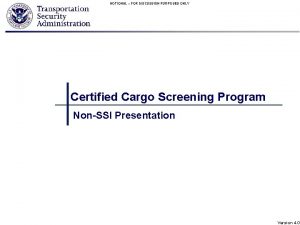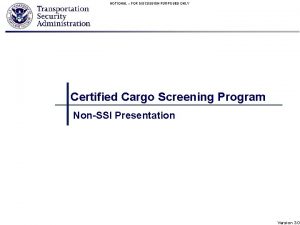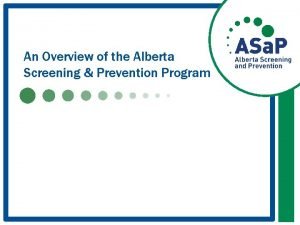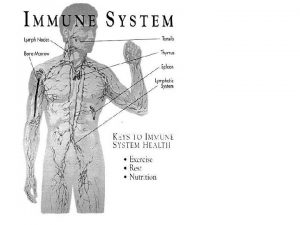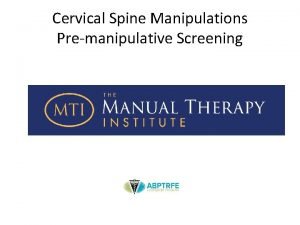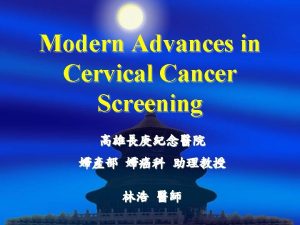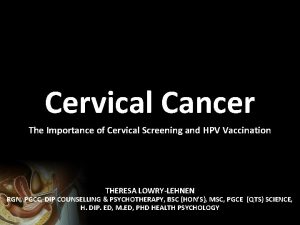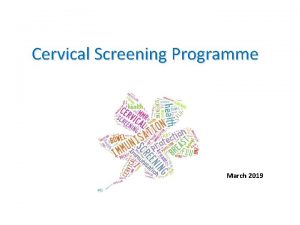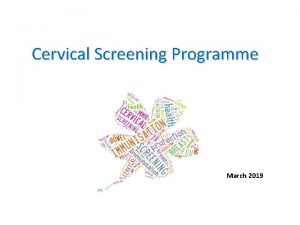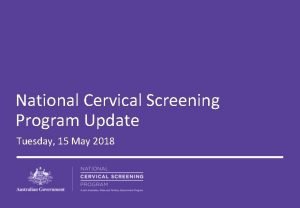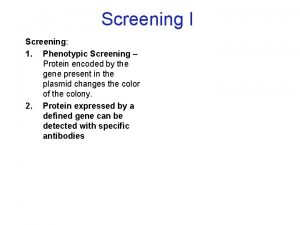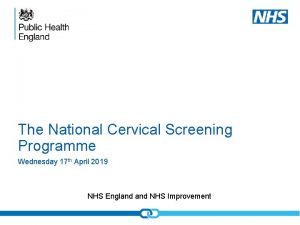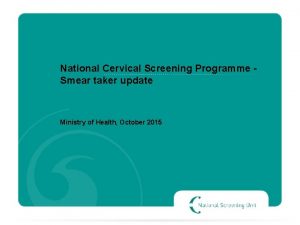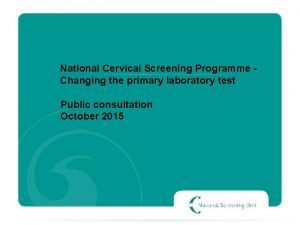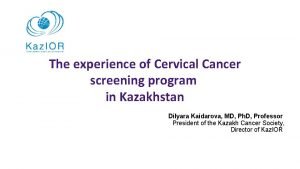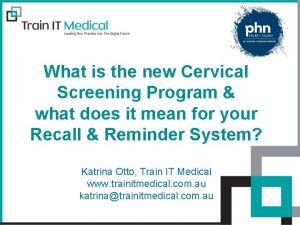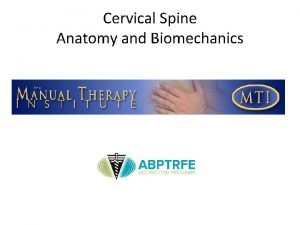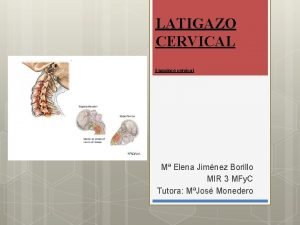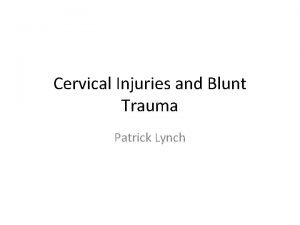Introducing the National Cervical Screening Program providing your















































- Slides: 47

Introducing the National Cervical Screening Program: providing your patients the right advice November 2017 Dr Hilary Bower Medical Coordinator Family Planning NSW

Aims of this session To understand the National Cervical Screening Program: implementation on December 1 st 2017 How to explain the National Cervical Screening Program to patients? How to access supporting resources?

Epidemiology of cervical cancer • Cervical cancer is the 15 th most commonly diagnosed cancer in Australian women, accounting for 1. 5% of cancers in Australian women • Since 1991, 50% decrease in mortality due to cervical cancer, largely due to our NCSP: a public health success story! • 80% of women with cervical cancer had not had a Pap smear in the previous 5 years Australian Institute of Health and Welfare. Cervical Screening in Australia 2013 -14. Canberra: AIHW 2016. Cancer Series no. 97 Cat. no. CAN 95. Australian Institute of Health and Welfare. Cancer in Australia 2017. Cancer series no. 101. Cat. no. CAN 100. Canberra: AIHW

Time for a change…. . Timely for Australia to take a lead with an evidence-based program based on: • new understanding of HPV & cancer • new testing technologies • a successful National HPV vaccination program

HPV: the ‘common cold’ of the genitals! • Up to 80% of people infected in their lifetime; usually resolves within 1 - 2 years • > 99% cervical cancer linked to oncogenic HPV subtypes • 14 oncogenic HPV types (16 & 18 more likely to persist detected in 70%– 80% cases cervical cancer) • Penetrative intercourse not strictly necessary; HPV can be transferred to the cervix from an infection at the introitus • Transmission via genital skin-to-skin contact, vaginal sex, oral sex & anal sex Ø Introduction of the Gardasil-9 in 2018!

The link between HPV infection and cervical cancer 2% of persistent oncogenic infections associated with cancer; takes about 10 years to develop CIN 3: up to a 1/3 will progress to invasive cancer within 10– 20 years

National Cervical Screening Program from 1 st December 2017 ensuring all women (vaccinated and unvaccinated) have access to a program that is acceptable, effective and efficient and based on current evidence Aim for up to 36 % fewer cervical cancers www. msac. gov. au

Understanding the new National Cervical Screening Program • All women who have ever been sexually active will be invited for Cervical Screening Test at 25 years • Women will be managed using a risk-based approach that is dependent on the cervical screening test results • Cervical screening may cease between 70 and 74 if regular screening tests with –ve results and a –ve exit result • Routine screening carried out every 5 years for women with no symptoms or history suggestive of cervical cancer • Invitations and reminders will be sent by the National Register to screen-eligible women

What is the Cervical Screening Test? The Cervical Screening Test has 2 components: 1. HPV DNA test with partial genotyping (to allow independent detection and reporting of HPV 16 and 18; other oncogenic HPV types are reported as a pooled result) 2. Reflex liquid based cytology (LBC) if the HPV test is +ve for any oncogenic HPV type (performed automatically on the sample); results of LBC used to inform colposcopy

Your essential guide…. “National Cervical Screening Program: Guidelines for the Management of Screen Detected Abnormalities, Screening in Specific Populations and Investigation of Abnormal Vaginal Bleeding. ” http: //wiki. cancer. org. au/australia/Guidelines: Cervical_cancer/Screening

Why is primary HPV testing replacing the Pap test? • A significant false-negative rate for Pap vs HPV tests (30% vs 23%) required more frequent screening to minimise failure to detect disease • Women who test HPV -ve are at very low risk of HSIL and cancer for at least 5 years • Compared with cytology, HPV testing provides 60– 70% greater protection against invasive cervical cancers; significantly reduced incidence of adenocarcinomas • Opportunity for self collection in under-screened populations Renshaw AA et al. Cancer Cytopathology 2001; 93: 106 -10 Dr Guglielmo Ronco et al. Lancet 2014; 383: 524 -32

Why use partial genotyping? • Partial genotyping allows for separate detection of HPV 16 and 18; other oncogenic HPV types will be reported as a pooled result • HPV 16 and 18 are associated with cervical abnormalities that are less likely to regress and more likely to progress to highgrade cervical abnormalities, compared with other oncogenic HPV genotypes • Improves risk stratification/assessment in the screening program Castle PE et al. Obstet Gynecol 2009; 113: 18 -25; Kjaer SK, et al. J Natl Cancer Inst 2010; 102: 1478 -88; Schiffman M, et al. Cancer Epidemiol Biomarkers Prev 2011; 20: 1398 -409

Explaining changes to the screening age: routine screening not recommended < 25 • Cervical cancer very rare in young women • Screening < 25 years has not reduced invasive cancer rates or deaths in this age group or in 25 -29 year olds • HPV vaccination already showing a reduction in screen-detected abnormalities in women <25 years of age • Cervical abnormalities common < 25 years and usually resolve; overdiagnosis and over-treatment not desirable • History of childhood sexual abuse or early sexual debut (< 14 years, prior to HPV vaccination): consider a HPV test between 20— 24 years • Symptomatic women of ANY age should be assessed with a co-test Peirson L et al Syst Rev 2013; 2: 35; Kyrgiou M, et al Lancet 2006; 367: 489 -98; Sasieni et al BMJ 2009; Schlect NF J Natl Cancer Inst 2003; 95: 1336 -43

A co-test is different to a Cervical Screening Test! A co-test is when a sample is tested for HPV DNA and cytology at the same time Not part of routine screening & must be specifically requested on the pathology request form: Ø at follow up of certain abnormalities eg glandular abnormalities after normal colposcopy Ø as part of Test of Cure (after treated CIN 2/3) Ø for some women post hysterectomy Ø for DES-exposed women Ø for women treated for adenocarcinoma in situ (AIS) Ø as part of Ix of abnormal vaginal bleeding or an abnormal looking cervix

What will change in clinical practice? • Discuss changes to the screening program for asymptomatic women • Transition clients to the new program • Collect the Cervical Screening Test using a liquid based medium (slides no longer used) • Order a CST on the pathology request form (or a co-test if indicated) Discuss results and risk assessment • Use the new management guidelines • Inform clients about the National Cancer Screening Register

The cervical screening pathway for asymptomatic women under National Cervical Screening Program (NCSP) from December 1 st 2017


What should you expect from a lab report? results are stratified by risk An overall cervical screening risk assessment: • Low risk – oncogenic HPV negative • Intermediate risk - e. g. HPV detected (not 16/18 and LBC negative or LSIL ) • Higher risk - e. g. HPV detected (16/18) A statement of test(s) performed and results: • HPV test result including LBC result (if performed) A recommendation for follow up: • taking account of result, screening history and clinical notes

Sara is +ve for HPV 16: what do you do? • Sara’s result is higher risk • referral to colposcopy regardless of LBC result • If LBC is unsatisfactory, repeat LBC at time of colposcopy • If LBC result predicts invasive disease referral within 2/52 • If LBC result PHSIL/HSIL referral within 8/52

Sara is +ve for HPV (non 16/18): what do you do? Reflex LBC Unsatisfactory Rpt LBC 6 -12/52 Normal or LSIL/PLSIL Rpt HPV 12/12 +ve HPV(any type)-colposcopy PHSIL/HSIL or any glandular Colposcopywithin 8/52 -ve HPV Retest 5 years Invasive disease Colposcopy within 2/52

Sara has a glandular abnormality? All glandular abnormalities refer to an expert gynaecologist for colposcopy including “Atypical endocervical/glandular cells of undetermined significance” Follow up of completely excised AIS: • annual co testing indefinitely • any abnormal result refer for a colposcopy

Unsatisfactory results: the Cervical Screening Test cannot be evaluated ‘unsatisfactory HPV’ or ‘unsatisfactory LBC’ test report • unsatisfactory HPV: test cannot be performed due to inhibition (e. g. too much blood) or insufficient human DNA in sample • unsatisfactory LBC: insufficient cells or technical problems such as excess blood or lubricant • advise a repeat sample 6 -12 weeks later after rectifying the reason (refer straight for colposcopy if unsatisfactory LBC and +ve HPV 16 or 18)

Maximising sample quality • Ensure adequate transfer of cellular material from the implements to the liquid medium • Use warm water rather than commercial lubricants to avoid cell agglutination and cellular loss (if used: avoid carbomer and carbopol polymer lubricants; use sparingly and avoid speculum tip) • Defer routine screening during menstruation but don’t delay diagnostic co-testing for abnormal vaginal bleeding • Avoid intravaginal medication for 48 hrs prior to testing

Self-collection of a vaginal HPV test http: //www. cancerscreening. gov. au/internet/screening/publishing. nsf/Content/re sources-menu

Self-collection of a vaginal HPV sample • Alternative for eligible under or never-screened women who have declined invitations to participate in conventional screening Eligibility: Ø 30 years + and never had cervical screening Ø 30 years + and overdue by 2 years or longer • Facilitated by a health professional within a healthcare clinic • Dry flocked swab self-inserted into vagina

Self-collection of a vaginal HPV sample • Lower sensitivity and specificity than a clinician-collected HPV sample (pooled sensitivity and specificity ratios of 0. 88 (0. 850. 91) and 0. 96 (0. 93 -0. 99) respectively for CIN 2 or worse • Cannot perform reflex LBC; if HPV 16 or 18 detected refer directly for colposcopy; other oncogenic HPV requires examination and clinician sample for LBC) Arbyn M et al. Lancet Oncol 2014; 15: 172 -83

Transition into the National Cervical Screening Program • Women aged 25 to 74 will be invited for a Cervical Screening Test two years after their last Pap test (new migrants & refugees) • Women already screened under 25 will be a sent a letter advising rescreening at age 25; an invitation letter (and reminders) will be sent from the NCSR at age 24 and 9 m • Women overdue by 2 years of more and >30 years old will be invited to screen and self collection an option. • Women under surveillance for an abnormal Pap test: follow guidelines Provide cytology screening if due until Dec 1 st!

Screening for specific populations: Pregnancy & Postpartum Post-menopause Early sexual activity Immune-compromise (screen every 3 years) Post-hysterectomy DES-exposure in utero Transgender men with a cervix (consider a short course of vaginal oestrogen) • Women with abnormal vaginal bleeding or an abnormal appearing cervix • •

Screening for specific populations • Pregnancy – perform if due (use a broom-type sampler brush NOT a cytobrush or combi-brush) Ø Self-collection not recommended • Postpartum - screen > 6 weeks after delivery; if breastfeeding or no menses, consider prior short course vaginal oestrogen • Post-menopausal – no recommendation for routine vaginal oestrogen; consider if vaginal dryness/superficial dyspareunia or if reflex LBC unsatisfactory due to atrophy, insufficient cells or inflammation or prior to colposcopy

Screening in specific populations: immunocompromised Immune-deficiency - HIV +ve or solid organ transplant recipients screen 3 yearly if normal screening history Consider 3 yearly screening in other immune-deficient women: Øcongenital primary immune deficiency Ø immunosuppressant therapy Øbone marrow transplant recipients Øscreening young women(20 -24 years) if immune deficient for more than 5 years. +ve HPV (any type) referral for colposcopy (with experienced gynaecologist) regardless of LBC result. . ))

Screening in specific populations: Diethylstilboestrol (DES) exposure • Women exposed to DES in utero: should be offered an annual cotest (HPV + LBC) and expert colposcopy and examination of the cervix and vagina indefinitely. • Not for self collection • No evidence of increased risk for ‘DES granddaughters’- routine screening recommended ( 5 yearly HPV testing) 1 Pharmaceuticals WHO 2012

Investigation of women with abnormal vaginal bleeding

Abnormal vaginal bleeding (post-coital, intermenstrual, postmenopausal) • Malignancy uncommon but must be excluded; consider pregnancy, STIs, polyps, coagulopathies, ovulatory disorders, endometrial disorders, vaginal atrophy, hormonal contraception • Women of ANY age with signs or symptoms suggestive of cervical cancer should have a co-test • Co-test: a HPV DNA test AND liquid based cytology on the sample • Co-test has high negative predictive value for HSIL/CIN 3 • Do not delay co-test due to the presence of blood: co-testing improves reduced sensitivity of individual tests Management of co-test results……. .

Investigation of women with abnormal vaginal bleeding

Management after treatment: Test of Cure Gynaecological review at 4 -6 months post treatment CIN 2/3 Subsequent surveillance is called a ‘Test of Cure’; usually performed in primary care: Øco-test (HPV and LBC) at 12 m and annually thereafter until all components negative on 2 consecutive occasions At anytime during Test of Cure: • +HPV 16/18 or • LBC PHSIL/HSIL colposcopy • any glandular lesion


Some groups are more likely to be under or never-screened • • • Aboriginal and Torres Strait Islander Culturally & Linguistically Diverse ( CALD) History of sexual trauma and/or domestic violence Living in a rural or remote areas, Identify as lesbian, bisexual, or same sex attracted Transgender men (with a cervix) Older women Women with disabilities (intellectual or physical) Women from lower socioeconomic status Women who have received the HPV vaccine

How to improve screening uptake? Ø Cultural awareness-including language barriers Ø Provide educational leaflets and posters Ø Stress importance of cervical screening as a preventative measure - prevents cancer Ø Asking if prefer to see a female colleague Ø Consider self-collection for eligible women

Understanding the National Cancer Screening Register Ø Single record for cervical & bowel cancer screening; will be linked to HPV vaccine registry Ø Records screening & colposcopy data; provides screening Hx to labs to inform recommendations Ø Health Care Provider portal Ø Consumer portal: limited information e. g. check due date for test or change address. Ø Sends letters of invitation and reminders; women can opt for reminders by mail, email or SMS; can nominate a personal representative Ø Women can ‘opt off’ by contacting the NCSR (initially by phone with or without support from clinician); previously via pathology request form and lab

The cervical screening consultation: what’s new and what’s the same • Discussion about screening; history taking; informed consent • Addressing screening barriers and opportunistically screening • Experience IS THE SAME FOR THE PATIENT with speculum examination • Sample of cells from squamo-columnar junction; no slides! • Opportunity for self-collection for eligible under-screened women • Completion of pathology request form for Cervical Screening Test (history, symptoms, examination) • Lab performs HPV test +/- reflex LBC • For specific indications order a co-test on the form

The cervical screening consultation: what’s new and what’s the same • Timely receipt of abnormal results; clear documentation of consultation and any follow-up • Discussion of results; risk assessment for cervical abnormality: Ø Low risk: invited to screen in 5 years Ø Intermediate risk: invited to screen in 12 m to check HPV clearance Ø Higher risk: referred for colposcopy • Using the new management guidelines • Informing women about the National Cancer Screening Register

Resources for women and health professionals http: //www. cancerscreening. gov. au/internet/screening/publishing. nsf/C ontent/resources-menu

Resources for health professionals Clinical guidelines wiki. cancer. org. au/australia/Guidelines: Cervical_cancer/Screening Clinical guidelines - Short Form Summary http: //wiki. cancer. org. au/australiawiki/images/2/2 e/National_Cervical_Screening_ Program_guidelines_short-form_PDF. pdf Clinical guidelines - Long Form Summary http: //wiki. cancer. org. au/australiawiki/images/a/ad/National_Cervical_Screening_ Program_guidelines_long-form_PDF. pdf

Resources Ø Background information on the Renewal www. msac. gov. au Ø NPS Medicine. Wise Learning modules on the changes to the National Cervical Screening Programhttps: //learn. nps. org. au/mod/page/view. php? id=7804 Ø National HPV Vaccination Program Register www. hpvregister. org. au Ø HPV vaccination www. cervicalcancervaccine. com. au

FPNSW resources • Talkline: phone 1300 658 886 • Reproductive and Sexual Health: an Australian Clinical Practice Handbook 3 rd edition • Fact Sheets: Cervical Screening and HPV vaccination https: //www. fpnsw. org. au/healthinformation/individuals/pap-test-and-cervical-screening • Everything you need to know about the changes to NSCP https: //www. fpnsw. org. au/changes

Key messages Ø Encourage eligible women (vaccinated and unvaccinated) to attend for cervical screening; opportunistically screen Ø New National Cervical Screening Program starts 1 st December; evidence-based tests and protocols Ø ‘More accurate and less harm’ Ø The Cervical Screening Test replaces the Pap test on 1 st December 2017 - no more slides! Ø Encourage primary prevention with HPV vaccination Ø Know where to go for information (including for specific populations)

Thank you and any questions?
 National breast and cervical cancer early detection program
National breast and cervical cancer early detection program National breast and cervical cancer early detection program
National breast and cervical cancer early detection program Expanded newborn screening
Expanded newborn screening Tsa certified cargo screening program
Tsa certified cargo screening program For discussion purposes only
For discussion purposes only Alberta screening and prevention program
Alberta screening and prevention program Give us your hungry your tired your poor
Give us your hungry your tired your poor Signal phrases examples
Signal phrases examples Rowe concise introduction to linguistics download
Rowe concise introduction to linguistics download Introducing james joyce
Introducing james joyce Quote analysis sentence starters
Quote analysis sentence starters Counterclaims in argumentative writing
Counterclaims in argumentative writing Unit 1 about myself
Unit 1 about myself How to introduce yourself in training session
How to introduce yourself in training session Ma
Ma Diamante examples
Diamante examples Digestive system introduction
Digestive system introduction Kfc pestle analysis
Kfc pestle analysis Integers essential questions
Integers essential questions Introducing internet
Introducing internet Introducing quotes sentence starters
Introducing quotes sentence starters New market offering
New market offering As he himself puts it the art of quoting summary
As he himself puts it the art of quoting summary Define upgrade advisor
Define upgrade advisor Khdmdcm calculator
Khdmdcm calculator Write a brief autobiography about yourself
Write a brief autobiography about yourself Stimulus diffusion definition
Stimulus diffusion definition Blood related relationships
Blood related relationships An introduction to the odyssey
An introduction to the odyssey Write a letter to an exchange student
Write a letter to an exchange student Carrying broker
Carrying broker Introducing family members in french
Introducing family members in french Safe agile
Safe agile Introducing government in america chapter 1
Introducing government in america chapter 1 Introducing flex pods
Introducing flex pods Dialogue leave taking
Dialogue leave taking Introducing neeta anil said
Introducing neeta anil said An introduction to rhetoric using the available means
An introduction to rhetoric using the available means Templates for introducing quotations
Templates for introducing quotations Templates for introducing quotations
Templates for introducing quotations Metric system basics
Metric system basics Self introduction
Self introduction Introducing quotes
Introducing quotes Psychology a journey
Psychology a journey Introducing illustrator 2013
Introducing illustrator 2013 The purpose of introducing weakened microbes
The purpose of introducing weakened microbes Introducing and naming new products and brand extensions
Introducing and naming new products and brand extensions Introducing and naming new products and brand extensions
Introducing and naming new products and brand extensions



